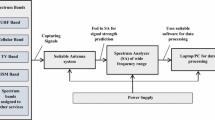Abstract
While dedicated spectrum occupancy monitoring provides vital information for frequency planning and management, it usually cannot tell the common properties in spectrum occupancy. As a complement, the models approach can be used to describe and compare the occupancy situations under similar conditions. Time series analysis has been applied to modeling the radio spectrum occupancy. This paper categorizes different time series models to different occupancy patterns. Occupancy analysis of the Global System for Mobile communications (GSM) band is given as an example.















Similar content being viewed by others
References
Ellingson, S. W. (2005). Spectral occupancy at VHF: implications for frequency-agile cognitive radio. Vehicular Technology Conference, IEEE 62nd, 2(15), 1379–1382.
Spaulding, A. D., & Hang, G. H. (1977). On the definition and estimation of spectrum occupancy. IEEE Transactions on Electromagnetic Compatibility, EMC, 19, 269–280.
Gibson, A. J., & Arnett, L. (1993). Statistical modelling of spectrum occupancy. IEE Electron. Lett, 29(25), 2175–2176. doi:10.1049/el:19931460.
Pantjiaros, C. A., & Gott, G. F. (1998). Extended UK models for high frequency spectral occupancy. IEE Proceedings. Communications, 145(3), 168–174. doi:10.1049/ip-com:19981711.
Sanders, F. (1996). Broadband spectrum survey at San Diego, California. Department of Commerce.
Brockwell, P., & Davis, R. (1998). Time series: Theory and methods. New York: Springer.
Box, G., Jenkins, G., Reinsel, G. (1994). Time series analysis: Forecasting & control. Prentice Hall.
Collett, D. (2003). Modelling binary data. Chapman & Hall/CRC.
Lempiäinen, J. (2007). Radio interface system planning for GSM/GPRS/UMTS. Springer.
Acknowledgements
This work is supported by Durham University and British Telecom.
Author information
Authors and Affiliations
Corresponding author
Rights and permissions
About this article
Cite this article
Wang, Z., Salous, S. Spectrum Occupancy Statistics and Time Series Models for Cognitive Radio. J Sign Process Syst 62, 145–155 (2011). https://doi.org/10.1007/s11265-009-0352-5
Received:
Revised:
Accepted:
Published:
Issue Date:
DOI: https://doi.org/10.1007/s11265-009-0352-5




